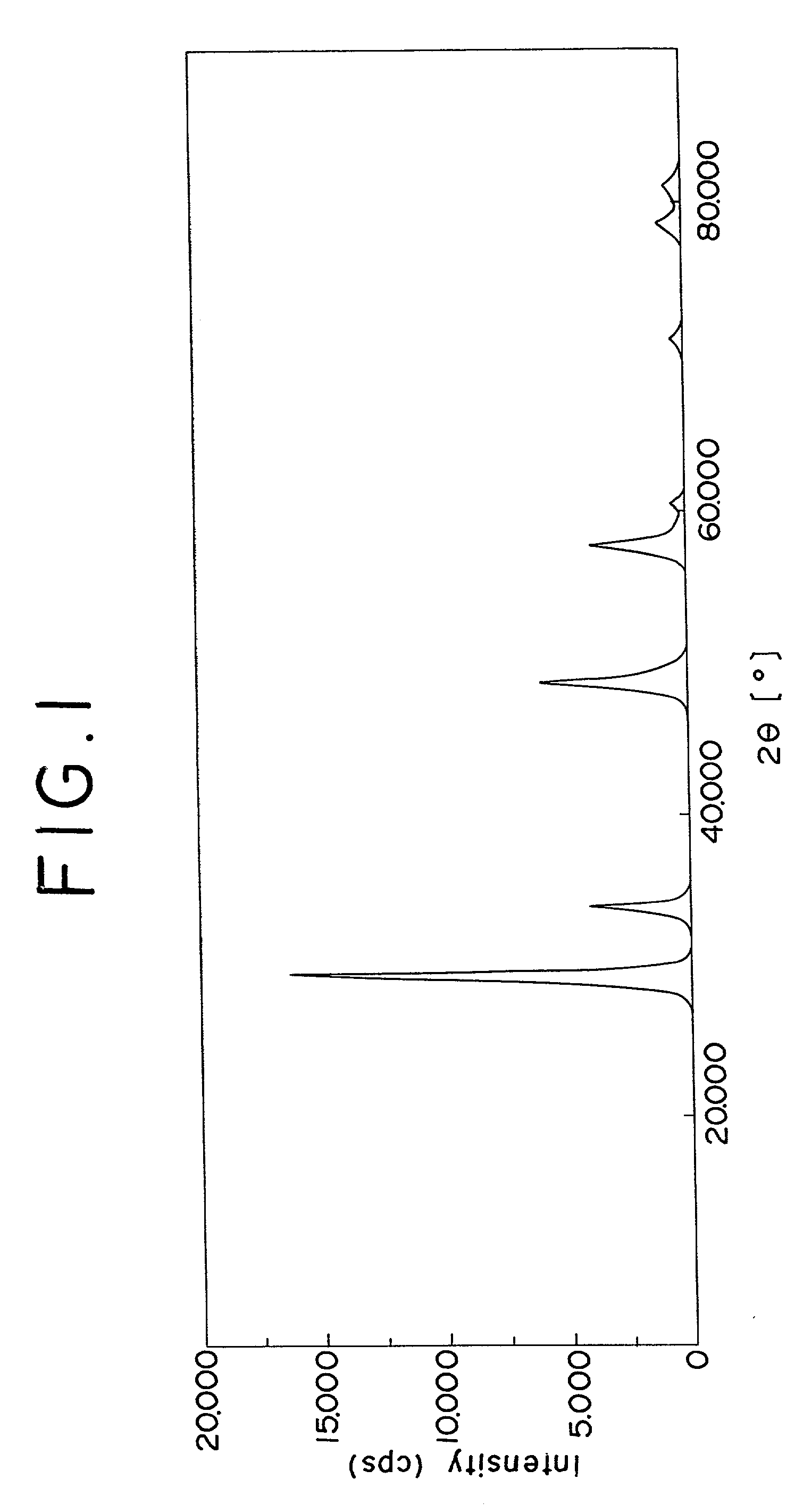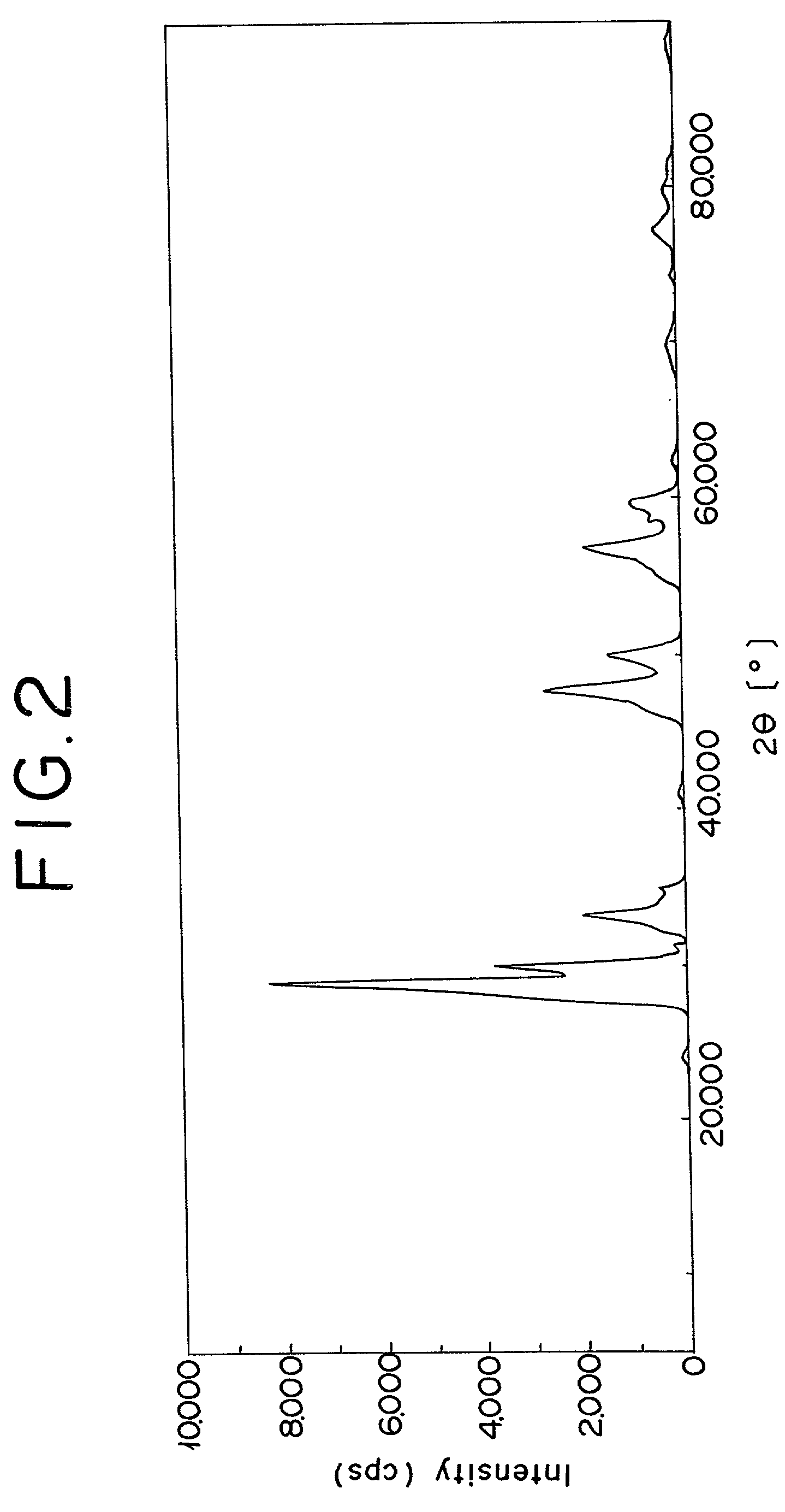Exhaust gas purifying catalyst
a technology of exhaust gas and purifying catalyst, which is applied in the direction of physical/chemical process catalysts, arsenic compounds, separation processes, etc., can solve the problems of heterogeneous crystal structure of solid solutions, high cost, and high cost of catalysts
- Summary
- Abstract
- Description
- Claims
- Application Information
AI Technical Summary
Benefits of technology
Problems solved by technology
Method used
Image
Examples
referential example
[0039] FIG. 1 shows the spectrum pattern, produced by the X-ray diffraction, of the zirconium oxide containing cerium and lanthanum in this invention, and FIG. 2 the spectrum pattern of the conventional zirconium oxide containing cerium and lanthanum. In FIG. 2, it is noted that the conventional oxide revealed the peaks of various independent oxides including cerium oxide. In FIG. 1, it is noted that the oxide used in Example 1 revealed only a peak of the tetragonal crystal structure of zirconium oxide. Other oxides of the present invention also reveal same results as in FIG. 1. Such oxides were evaluated after each the samples had been aged in air at 1000.degree. C. for 10 hours.
[0040] Next, the zirconium oxide containing cerium and lanthanum in this invention and the conventional zirconium oxide containing cerium and lanthanum are compared in the amount of oxygen stored that expresses the ability to adsorb and desorb oxygen. The results are shown in Table 1.
1 TABLE 1 Amount of oxy...
example 1
[0042] A zirconium-cerium-lanthanum composite oxide (Powder A1) was obtained by hydrolyzing a zirconium oxychloride solution thereby obtaining zirconium hydroxide, adding an aqueous nitric acid solution of cerium and lanthanum to the zirconium hydroxide and mixing them together, neutralizing the resultant mixture by addition of an alkali, washing, drying at 120.degree. C. for two hours and calcining at 700.degree. C. for one hour the product of neutralization, with the relevant components used in amounts calculated to form a weight ratio of 40 g of zirconium oxide, 20 g of cerium oxide, and 15 g of lanthanum oxide.
[0043] A quantity of 40 g of Powder A1 was impregnated with an aqueous palladium nitrate solution containing 2 g of palladium. Thereafter, the impregnated composite oxide was dried thoroughly at 150.degree. C. and then calcined at 500.degree. C. for one hour to obtain a palladium-containing zirconium-cerium-lanthanum composite oxide (Powder B1).
[0044] Separately, 30 g of a...
example 2
[0047] A zirconium-cerium-lanthanum composite oxide (Powder A2) was obtained according to the procedure of Example 1 while changing the amounts of zirconium oxychloride, cerium, and lanthanum to be used so as to form a weight ratio of 25 g of zirconium oxide, 12.5 g of cerium oxide, and 9.5 g of lanthanum oxide.
[0048] Next, a palladium-containing zirconium-cerium-lanthanum composite oxide (Powder B2) was obtained according to the procedure of Example 1 while using 47 g of Powder A2 instead of 40 g of Powder A1.
[0049] In a ball mill, 49 g of Powder B2, 103 g of alumina (.gamma.-Al.sub.2O.sub.3) having a specific surface area of 150 m.sup.2 / g, 10 g equivalent of barium hydroxide as an oxide, 5 g of acetic acid, and 150 g of deionized water were ball milled for 15 hours to form a water slurry. A monolithic carrier (supra) was coated with the slurry as in Example 1 to obtain catalyst 2.
PUM
| Property | Measurement | Unit |
|---|---|---|
| temperature | aaaaa | aaaaa |
| temperature | aaaaa | aaaaa |
| temperature | aaaaa | aaaaa |
Abstract
Description
Claims
Application Information
 Login to View More
Login to View More - R&D
- Intellectual Property
- Life Sciences
- Materials
- Tech Scout
- Unparalleled Data Quality
- Higher Quality Content
- 60% Fewer Hallucinations
Browse by: Latest US Patents, China's latest patents, Technical Efficacy Thesaurus, Application Domain, Technology Topic, Popular Technical Reports.
© 2025 PatSnap. All rights reserved.Legal|Privacy policy|Modern Slavery Act Transparency Statement|Sitemap|About US| Contact US: help@patsnap.com


